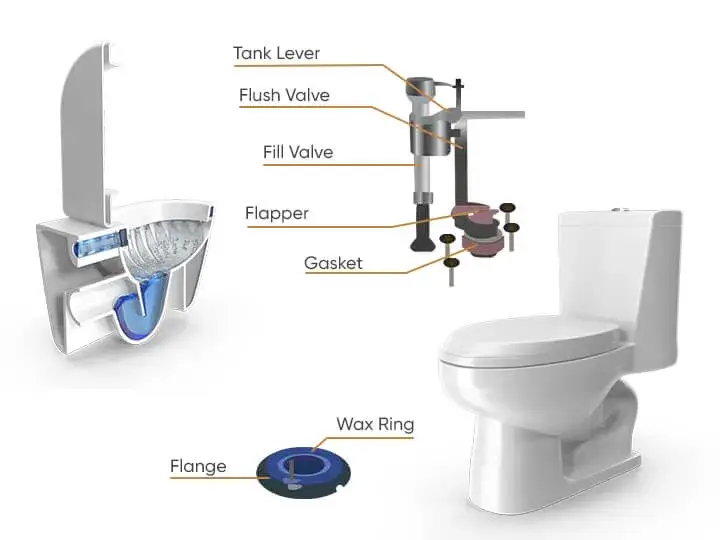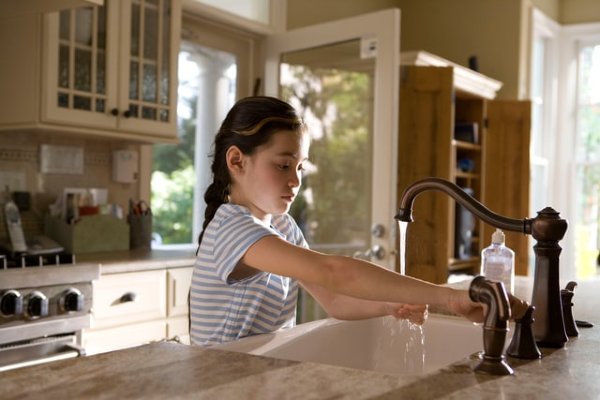The North American toilet is part and parcel of most homes and offices. It plays an integral role in the everyday elimination of our waste, depending on multiple parts for efficient working.
Here’s a close look at the different toilet parts and the parts that can break. Knowing this will help you understand how to handle any future potential toilet issues and know when you should call professional plumbers to tackle the problem.
The different parts of a toilet
Tank lever
It’s the tank lever you use to flush the toilet after using it. They have a flapper and other seals that open up to let water and waste down the flush valve and into the bowl when pushed.
Time and wear and tear can lead to the need to replace the tank lever. In this case, you get different tank lever styles and finishes to choose from based on your bathroom decor.
This wide available choice makes upgrading and replacing easy and convenient if you notice your lever making weird sounds.
Or if you have any difficulties using it.
These are all possible indications of trouble that you should preferably nip in the bud. Just call Dima Plumbing services to take care of all your plumbing needs in Toronto.
Handle
The handle lifts the stopper upwards to drain water out of the tank into the bowl quickly. The handles don’t need to support much weight, and to cut costs, they are usually of low-grade metal.
However, constant exposure to the tank water can lead to its eventual corrosion and failure with time.
You know you have a problem if nothing happens when you lift or press the toilet handle. While it’s easy to repla98ce handles, not all handles fit all bathrooms. So select the handle based on your preferred style and previous flushing action.
Fill valve
The fill valve opens and closes your toilet’s water supply connection to fill your toilet’s reservoir tank. Use and tear can lead to its breakage and these possible consequences:
- The valve does not close at all, leading to water continuously flowing into the tank
- Water blasting upwards from the fill valve and drips out of the tank onto the floor
- The valve does not open wherein the toilet flushes but doesn’t refill
You can easily replace the fill valve outright using standard pliers and needle-nose pliers. And in case of a stuck float that doesn’t open, just apply some lubricant to the hinge connecting the float to the valve, and it will help the float move freely once again.
Though both tasks seem relatively easy to do, it is always better to be on the safer side. For a better and more professional job and to minimize unnecessary complications, leaving all plumbing issues to the professionals is better.
This is where Dima Plumbing can help; always ready to serve the people of Toronto and GTA with all their plumbing needs.
Flapper
The flapper or stopper in the toilet tank’s bottom effectively protects water from draining into the toilet bowl and completes the ‘flush cycle.’ Flappers are built of a flexible material that quickly provides a solid and full seal that moulds to the drain and covers it.
They are, nevertheless, prone to rust and will eventually come apart due to their fragility.
You know your flapper is worn out and needs replacement when:
- Your toilet emits an obnoxious dripping sound, even when not in use.
- The toilet turns on and runs even if no one uses or flushes it.
These are indications of plumbing issues you should not ignore as they only lead to an unnecessary waste of water. Call your local plumber near you, Dima Plumbing services, to handle all your plumbing problems.
The line for the water supply
The two most important connections you’ll discover in a toilet are:
- The water supply line and the shutdown valve
- The fill valve and the water delivery line
The average lifespan of a water supply line is ten years. They may, however, spring a leak due to worn parts or a loose connection. Hand-tightening and adjustments remedy the problem if the water supply line and fill valve connection are missing.
If the problem persists and the shutoff valve connection is not leaking, you may need to replace the water supply line.
Seal made of wax
The wax seal is responsible for separating your toilet from the sewage by surrounding the toilet’s exit hole. It is a wax or non-wax seal that is watertight, airtight, and provides the following safety features:
- The seal stops water from escaping into the drainpipe as it exits the toilet. In the process, it prevents mould, mildew, and rot from forming and causing damage to your home or office structure.
- The seal keeps sewer gas out of your space, which is potentially caustic, combustible, and deadly.
If you detect foul odours in your bathroom, wobbling fixtures, or possibly around the toilet base, it’s time to repair the seal. Toilet seals are simple to install, but replacing them can be a hassle.

Toilet bowl
Replacing porcelain toilet bowls is an urgent repair job. And unfortunately, they crack and break easily, especially if you don’t treat them carefully. While you can seal hairline cracks using epoxy, it can be challenging to repair if the crack grows.
Several factors can lead to a cracked toilet bowl:
- There are sudden temperature fluctuations while pouring hot or warm water into the bowl or tank to remove clogs.
- Impacts from heavy or sharp objects like scissors, kids kicking, jumping, or slamming on the toilet, or heavy objects stored on the toilet tank cover.
- Dropped or misused tools while removing or reseating the toilet.
- Under tightening of nuts and bolts can lead to a wobbling, rocking, or cracked toilet bowl, and over tightening can break the bowl.
- Age or wear or tear, especially in older toilets made of different materials
Whatever the reason is, turn off the water and contact Dima Plumbing services if you notice water leaking from the crack.
Drain
The drain is the one part of the toilet that is most prone to problems. And it’s not surprising as it is responsible for hauling away the waste and water that you flush through it.
With time and wear and tear, there is a chance of your ending with a clogged drain.
A plunger provides the most straightforward and quickest solution for clogged drains but may not always provide a permanent solution. It’s better to call the professionals to eliminate persistent and recurring clogs.
The toilet serves an essential role in our everyday lives, but you never know when one or more of its parts may need repair or replacement. While you may be able to perform some repairs, it is better to leave the more extensive and significant maintenance and replacement work to the professionals, Dima Plumbers.
They have the expertise, tools, and knowledge to buy and use the best parts to give you a fully functioning toilet in no time at all.


